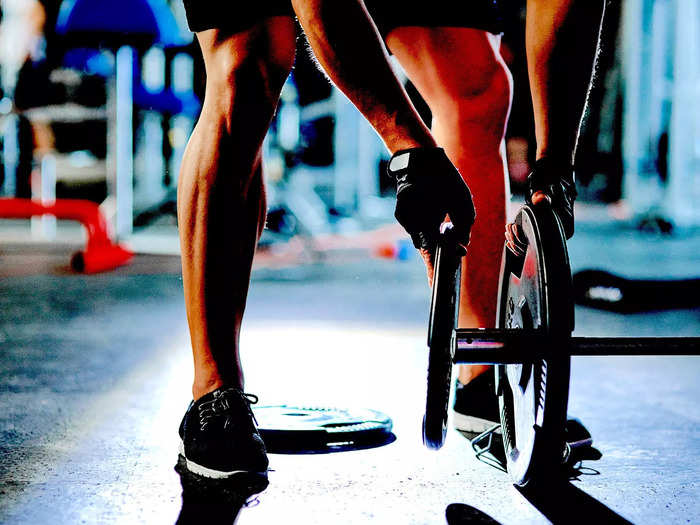10 weightlifting mistakes that are stalling your gains and how to fix them, according to experts
Gabby Landsverk

- Weightlifting can help you build muscle, burn fat, and improve overall health.
- Anyone can lift weights, but everyone should avoid common mistakes to maximize gains.
Lifting weights is a great way to boost your overall health and fitness, with benefits like muscle building, stronger bones and joints, and support for your cardiovascular system. Anyone can start training with weights, regardless of their fitness experience.
While lifting, get the most of your workouts by avoiding common mistakes. Poor planning can leave you feeling drained in the gym without getting the results you want.
Experts told Insider habits like overtraining and under eating could stall your progress. You can get back on track by incorporating new tactics into your fitness routine, like prioritizing diet and recovery.
Exercising too much or too intensely can backfire

Athletes who try to do too much exercise or workout too intensely can end up slowing their progress, burning out, and increasing the risk of injury, Chris Duffin, a world-record-holding powerlifter and cofounder of Kabuki Strength, previously told Insider.
"More is not better. You want to do the least amount to get the result you want," he said.
For beginners, working out three times a week for 45 minutes each session is plenty, Duffin said. Even more experienced athletes can see benefits from working each muscle group just twice a week, so there's no need for long hours of exercise.
Red flags of overworking in the gym include persistent fatigue or soreness, moodiness or irritability, decreased range of motion, and inability to finish workouts or lift the same amount of weight.
Losing sleep can prevent muscles from growing back stronger

The flip side of overtraining is under recovering, according to weightlifting experts.
Sleep is a crucial part of recovery to support your body in getting stronger after each workout.
Without sleep, damaged muscle tissue doesn't have the opportunity to repair and grow, and gains can stall.
It's a common problem for athletes who get up too early in the morning to train, according to Duffin. While morning workouts can be convenient, they're not worth it if you're missing out on sleep.
"It's like bending over to pick up a dime and missing the $10 bill in front of you. It doesn't make sense," he said.
While sleep needs can vary, most research suggests seven to nine hours is a good nightly goal for adults. Dedicated athletes may need more, as much as 10 hours a day, some studies indicate.
Skipping active recovery can make rest days less effective

While rest days are nonnegotiable, they don't necessarily mean sitting on the couch — in fact, the best recovery may include movement, research suggests.
Active recovery refers to light exercise to promote healing and ease soreness without causing additional strain.
Good strategies include concentric exercises like sled pushes or biking, according to Stan Efferding, a world-record-holding powerlifter, pro bodybuilder, and coach. They work by stimulating blood flow to reduce soreness after a tough lifting session and on rest days, he previously told Insider.
Efferding also recommends starting your active recovery immediately after a gym session by incorporating the same exercises as in your workout but with lighter weights and more speed.
Walking, jogging, or swimming are also good low-impact ways to get your blood flowing for better recovery.
Not having a plan or consistent program will eventually stall your progress

Any amount of exercise is better than nothing, but working out without a plan limits how quickly you improve and build muscle, experts say.
"People are trying to find the secret sauce," Duffin said. "They'll try an approach for a month and then hop to the next thing, but the only way you can learn what works for you is to stick with something."
Staying with a program for at least six months is a good start, he said.
Examples of popular formats include workout splits and programs that focus on specific styles of weight training, such as powerlifting or CrossFit.
For most people, following a program designed by qualified experts is your best bet, since writing your own workouts takes time, knowledge, and experience.
Set programming can also help prevent other mistakes such as overtraining, since a good coach will know how much work you can benefit from.
Not challenging yourself week to week may lead to plateaus

While consistency is key to a good fitness routine, it doesn't mean doing the same thing each workout. Over time, you'll notice a workout will start to get less difficult as your body adapts. But your gains can stall if it becomes too easy.
You need to challenge your muscles to prompt them to continue growing, a foundational concept in fitness called "progressive overload."
"You need to increase the intensity and volume to get results," Duffin said.
The simplest way to increase a workout's difficulty is by adding more reps or sets to an exercise or adding more weight. Duffin recommends an increase of about 10 to 15% over a period of four to six weeks.
For example, if your workout includes four sets of 10 repetitions at 20 pounds, you might work up to four sets of 10 repetitions at 22 pounds or four sets of 11 to 12 reps at 20 pounds.
Under eating deprives your body of the energy it needs to grow muscle

Many people who start a new strength-training routine make the mistake of starting a new diet at the same time, but experts don't recommend it.
To build muscle effectively, you need to be in a calorie surplus, which means eating more food than you burn off in the form of exercise and daily activities. Cutting calories too much can slow muscle growth, worsen fatigue, and impair your progress.
If you want to maximize your gains, you may even want to consider eating extra — "bulking," or intentionally gaining weight to build muscle, is common among fitness professionals.
For best bulking results, aim for a calorie surplus of about 10 to 20% above what you need to maintain your weight, Layne Norton, a nutrition and fitness coach, bodybuilder, and powerlifter with a Ph.D. in nutrition, told Insider.
Try to be consistent with a bulking routine for at least three to four months to see progress, he said.
Skimping on carbs or protein may make gaining more difficult

Eating enough is important, but what you eat matters, too.
Protein is an essential nutrient for repairing muscle tissue, so getting enough of it is crucial to a lifting routine.
Norton said to eat about gram of protein per pound of bodyweight. Good protein sources include eggs, chicken, fish, yogurt, and legumes like beans, peas, and quinoa.
You can supplement with protein shakes or bars, but these can sometimes be high in additives like sugar, and many experts recommend prioritizing whole foods.
Carbohydrates are also needed to provide energy during the workout itself and can help you recover when combined with protein after a gym session. Fruit, whole grains, and root vegetables like sweet potatoes are nutritious carb options.
Try to eat a wide variety of foods, and avoid extremes of either low-carb or low-fat diets, Norton said.
Healthy fat sources include fish, olive oil, avocados, nuts, and seeds.
Doing isolation exercises instead of compound movements can slow your progress

Depending on your fitness goals, you may want to step away from the weight machines and pick up a barbell.
Exercises that isolate one muscle group aren't the most efficient way to make gains for most people, according to experts. Cables, weight machines, and dumbbell exercises like bicep curls are all included in this category. They often target small muscles like the arms or abs, which don't offer much of a calorie burn, either.
Compound movements that work many muscle groups at once allow you to build full-body strength. They can also help burn fat by torching calories, particularly if the exercise recruits big muscles like the legs.
Examples include deadlifts, squats, and presses. Compound exercises are great for beginners to get quick results, Noam Tamir, the founder and CEO of TS Fitness, previously told Insider.
But isolation exercise can be a good option for more advanced athletes (such as bodybuilders) and help target specific muscle groups (often underrated areas like the back or hips).
Not prioritizing specific goals can leave you spinning your wheels in the gym

Strength-training beginners can improve relatively quickly doing just about any program, a phenomenon known as newbie gains.
As you advance in your fitness career, gains happen more slowly. If you're not focusing on any particular skill or goal, your progress can easily stall.
To avoid frustrating plateaus, prioritize what you want to achieve, rather than trying to do it all, Duffin said.
"You can't expect everything to get better at once," he said.
Targeting one muscle group, like your shoulders or glutes, to train twice a week can boost your progress more than full-body workouts, Duffin said.
Then, as you begin to see gains in that area, you can shift your focus to another target and repeat for cycles of about six weeks.
The technique of creating programming "blocks" to emphasis one goal is called periodization — it works to improve not just muscle groups but also skills, like Olympic lifts.
Stop being impatient — muscle growth takes time

Topping the list of mistakes people make in the weight room, according to experts, is not waiting long enough to see the results you want.
Too many athletes have unrealistic goals or an arbitrary timeline for reaching them, which can lead to frustration, burnout, and quitting.
Muscle takes years to build. Beginners might expect to gain 4 to 7 pounds in three months. For experienced athletes, 2 to 4 pounds in the same time period is a reasonable pace, research suggests.
Rather than rushing, trust the process. One way to stay motivated and focused is to track your progress in multiple ways, such as how much your strength or stamina increases each week.
Even if you have physique goals like weight loss or ripped abs, performance achievements are a good reminder you're on the right track, whether you notice it in the mirror or not.
Duffin said a slow, steady approach may take patience, but it's the best way to ensure the longevity of your gains.
"The beauty of strength training is that it continues to be progressive over time," he said.
READ MORE ARTICLES ON
Popular Right Now
Popular Keywords
Advertisement